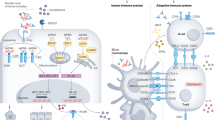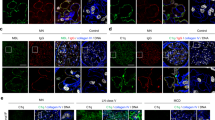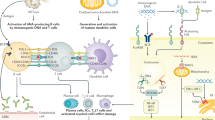Abstract
The complement system plays a paradoxical role in the development and expression of autoimmunity in humans. The activation of complement in systemic lupus erythematosus (SLE) contributes to tissue injury. In contrast, inherited deficiency of classical pathway components, particularly C1q (ref. 1), is powerfully associated with the development of SLE. This leads to the hypothesis that a physiological action of the early part of the classical pathway protects against the development of SLE (ref. 2) and implies that C1q may play a key role in this respect. C1q-deficient (C1qa−/−) mice were generated by gene targeting and monitored for eight months. C1qa−/− mice had increased mortality and higher litres of autoantibodies, compared with strain-matched controls. Of the Clqa−/− mice, 25% had glomerulonephritis with immune deposits and multiple apoptotic cell bodies. Among mice without glomerulonephritis, there were significantly greater numbers of glomerular apoptotic bodies in C1q-deficient mice compared with controls. The phenotype associated with C1q deficiency was modified by background genes. These findings are compatible with the hypothesis that C1q deficiency causes autoimmunity by impairment of the clearance of apoptotic cells.
This is a preview of subscription content, access via your institution
Access options
Subscribe to this journal
Receive 12 print issues and online access
$209.00 per year
only $17.42 per issue
Buy this article
- Purchase on Springer Link
- Instant access to full article PDF
Prices may be subject to local taxes which are calculated during checkout
Similar content being viewed by others
References
Walport, M.J. & Morgan, B.P. Complement deficiency and disease. Immunol. Today 12, 301–306 (1991).
Lachmann, P.J. & Walport, M.J. Deficiency of the effector mechanisms of the immune response and autoimmunity. in Ciba Foundation Symposium: Autoimmunity and Autoimmune diseases (ed. Whelan, J.) 129, 149–171 (Wiley, Chichester, 1987).
McAdam, R.A., Goundis, D. & Reid, K.M.B. A homozygous point mutation results in a stop codon in the C1q B-chain of a Clq-deficient individual. Immunogenetics 27, 259–264 (1988).
Bowness, P. et al. Hereditary C1q deficiency and systemic lupus erythematosus. Quart. J. Med. 87, 455–464 (1994).
Petry, F., Le, D.T., Kirschfink, M. & Loos, M. Nonsense and missense mutations in the structural genes of complement component C1q A and C chains are linked with two different types of complete selective C1q deficiencies. J. Immunol. 155, 4734–4738 (1995).
Slingsby, J.H. et al. Homozygous hereditary C1q deficiency and systemic lupus erythematosus. A new family and the molecular basis of C1q deficiency in three families. Arthritis Rheum. 39, 663–670 (1996).
Topaloglu, R. et al. Molecular basis of hereditary C1q deficiency associated with SLE and IgA nephropathy in a Turkish family. Kidney Int. 50, 635–642 (1996).
Petry, F., Izzet Berkel, A. & Loos, M. Multiple identification of a particular type of hereditary C1q deficiency in the Turkish population: review of the cases andadditional genetic and functional analysis. Human Genet. 100, 51–56 (1997).
Petry, F. et al. The mouse C1q genes are clustered on chromosome 4 and show conservation of gene organisation. Immunogenetics 43, 370–376 (1996).
Jevnikar, A.M., Slinger, G.G., Brennan, D.C., Xu, H.W. & Kelley, V.R. Dexamethasone prevents autoimmune nephritis and reduces renal expression of la but not costimulatory signals. Am. J. Pathol. 141, 743–751 (1992).
Baker, A.J. et al. Mesangial cell apoptosis: the major mechanism for resolution of glomerular hypercellularity in experimental mesangial proliferative nephritis. J. Clin. Invest. 94, 2105–2116 (1994).
Korb, L.C. & Ahearn, J.M. C1q binds directly and specifically to surface blebs of apoptotic human keratinocytes. Complement deficiency and systemic lupus erythematosus revisited. J. Immunol. 158, 4525–4528 (1997).
LeFeber, W.P. et al. Ultraviolet light induces binding of antibodies to selected nuclear antigens on cultured human keratinocytes. J. Clin. Invest. 74, 1545–1551 (1984).
Golan, T.D., Elkon, K.B., Gharavi, A.E. & Krueger, J.G. Enhanced membrane binding of autoantibodies to cultured keratinocytes of systemic lupus erythematosus patients after ultraviolet B/ultraviolet A irradiation. J. Clin. Invest. 90, 1067–1076 (1992).
Casciola-Rosen, L.A., Anhalt, G. & Rosen, A. Autoantigens targeted in systemic lupus erythematosus are clustered in two populations of surface structures on apoptotic keratinocytes. J. Exp. Med. 179, 1317–1330 (1994)
Rosen, A., Casciola-Rosen, L.A. & Ahearn, J. Novel packages of viral and self-antigens are generated during apoptosis. J. Exp. Med. 181, 1557–1561 (1995).
Casciola-Rosen, L.A., Rosen, A., Petri, M. & Schlissel, M. Surface blebs on apoptotic cells are sites of enhanced procoagulant activity: Implications for coagulation events and antigenic spread in systemic lupus erythematosus. Proc. Natl. Acad. Sci. USA 93, 1624–1629 (1996).
Trinder, P., Faust, D., Petry, F. & Loos, M. Modulation of mRNA expression and secretion of C1q in mouse macrophages by anti-inflammatory drugs and cAMP: evidence for the partial involvement of a pathway that includes cyclooxygenase, protaglandin E2 and adenylate cyclase. Immunol. 84, 638–644 (1995).
Andrews, B.S. & Theofilopoulos, A.N. A microassay for the determination of hemolytic complement activity in mouse serum. J. Immunol. Methods 22, 273–281 (1978).
Burlingame, R.W. & Rubin, R.L. Subnucleosome structures as substrates in enzyme-linked immunosorbent assays. J. Immunol. Methods 134, 187–199 (1990).
Author information
Authors and Affiliations
Corresponding author
Rights and permissions
About this article
Cite this article
Botto, M., Dell' Agnola, C., Bygrave, A. et al. Homozygous C1q deficiency causes glomerulonephritis associated with multiple apoptotic bodies. Nat Genet 19, 56–59 (1998). https://doi.org/10.1038/ng0598-56
Received:
Accepted:
Issue Date:
DOI: https://doi.org/10.1038/ng0598-56
This article is cited by
-
Physiology and diseases of tissue-resident macrophages
Nature (2023)
-
Fc-γR-dependent antibody effector functions are required for vaccine-mediated protection against antigen-shifted variants of SARS-CoV-2
Nature Microbiology (2023)
-
Complosome — the intracellular complement system
Nature Reviews Nephrology (2023)
-
Developmental programming: adverse sexually dimorphic transcriptional programming of gestational testosterone excess in cardiac left ventricle of fetal sheep
Scientific Reports (2023)
-
Complement component C1q is an immunological rheostat that regulates Fc:Fc\(\gamma\)R interactions
Immunogenetics (2023)



